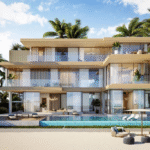Now Reading: UAE Property Market 2025: What to Expect
-
01
UAE Property Market 2025: What to Expect
UAE Property Market 2025: What to Expect

Table of Contents
The UAE property market, valued at AED 893 billion with 331,240 transactions in 2024, is gearing up for a transformative year in 2025. As a global real estate hub, the United Arab Emirates—particularly Dubai, Abu Dhabi, Sharjah, Ajman, and Ras Al Khaimah—continues to attract investors, expats, and residents with its investor-friendly laws, diverse housing options, and economic resilience.
Fueled by the Dubai Vision 2030, Abu Dhabi Economic Vision 2030, and a projected 25 million tourists in 2025, the market is poised for 5–7.5% price growth and 6–10% rental yields. This article explores key trends, opportunities, challenges, and what buyers and investors can expect in the UAE property market in 2025, with insights from industry experts and recent data as of June 2, 2025.
A Booming Market with Strong Foundation

The UAE real estate sector has shown remarkable growth, with Dubai alone recording AED 46.14 billion in sales across 17,000 transactions in Q1 2025, according to the Dubai Land Department. Abu Dhabi’s market surged with 14,662 transactions in 2024, reflecting a 10.1% increase in house prices, per Property Finder. The market’s strength is underpinned by:
- Economic Diversification: The UAE’s shift from oil to tourism, tech, and real estate, supported by free zones like DMCC and RAK Free Zone, drives demand.
- Government Policies: Golden Visa reforms (AED 2 million property threshold for 10-year residency) and 100% foreign ownership laws introduced in 2021 attract global investors.
- Population Growth: With 88% of the UAE’s 10 million population being expats, demand for affordable and luxury homes remains high, per Khaleej Times.
“2025 will be a pivotal year for UAE real estate,” says Sarah Al-Mansoori, a senior analyst at Loam Properties. “The market is balancing affordability with luxury, while sustainability and technology are becoming non-negotiable for buyers.”
Key Trends Shaping the 2025 Property Market
1. Surge in Off-Plan Properties
Off-plan properties dominated 56% of Dubai’s Q1 2025 transactions, totaling AED 140 billion, per Dubai Land Department. These pre-construction homes offer 10–20% lower prices and 15–20% capital appreciation upon completion, making them attractive for investors. Flexible payment plans (e.g., 60/40 post-handover) and escrow protections under Dubai’s Law No. 13 of 2020 reduce risks.
- Hot Projects:
- The Oasis, Dubai: Emaar’s AED 73 billion waterfront project, with villas starting at AED 3 million, promises 6.5% yields and 20% appreciation by 2027.
- Yas Acres, Abu Dhabi: Aldar’s villas (AED 2.5–5 million) offer 6% yields, targeting families and tourists.
- Aljada, Sharjah: Arada’s apartments (AED 500,000–1 million) yield 7.5%, appealing to budget-conscious buyers.
“Off-plan is a smart choice for long-term investors, but due diligence is key,” advises John Carter, a real estate consultant at Bayut. “Check developer track records and escrow accounts via platforms like Dubai REST.”
2. Demand for Sustainable Homes

Sustainability is a top priority, with 70% of buyers seeking eco-friendly homes, per a 2024 Property Finder survey. The UAE Net Zero 2050 Strategy and Dubai’s Law No. 16 of 2023 mandate green building standards, boosting demand for properties with solar panels, water recycling, and smart tech.
- Prime Locations:
- The Sustainable City, Dubai: Net-zero villas (AED 2.5–3.5 million) save AED 40,000/year on utilities, yielding 7.5%.
- Saadiyat Grove, Abu Dhabi: Estidama Pearl 2 apartments (AED 1.5–2.5 million) offer 5.5% yields.
- Masaar, Sharjah: Forest-inspired townhouses (AED 1.2–1.8 million) yield 6.5%.
“Sustainable homes aren’t just eco-friendly; they’re cost-effective,” says Aisha Khan, a sustainability expert at Aldar Properties. “Buyers save 20–30% on bills, and resale values are 10–20% higher.”
3. Short-Term Rentals Thrive
With 25 million tourists expected in 2025, short-term rentals (e.g., Airbnb) offer 8–12% yields, outpacing long-term rentals (5–7%), per AirDNA. Dubai’s DTCM licensing and Ajman’s Holiday Homes Services simplify operations, while high occupancy rates (80–90% in peak seasons) drive profits.
- Top Areas:
- Dubai Marina: Apartments (AED 1.5–2 million) yield 10% via Airbnb
- Ajman Corniche: Budget apartments (AED 500,000–800,000) yield 9%.
- Al Marjan Island, RAK: Resort-style apartments (AED 1–2 million) yield 8%.
“Tourism is a game-changer,” notes Michael Lee, a rental specialist at ROI HUB. “A AED 600,000 studio in JVC can earn AED 54,000/year on Airbnb, versus AED 36,000 long-term.”
4. Emerging Emirates Gain Traction
While Dubai and Abu Dhabi dominate, Sharjah, Ajman, and Ras Al Khaimah offer affordable investments with 7–9% yields, per Bayut. Government projects like Sharjah’s AED 24 billion Aljada and RAK’s Wynn Al Marjan Island fuel growth.
- Key Picks:
- Aljada, Sharjah: Apartments (AED 500,000–1 million) with 7.5% yields, near Dubai.
- Al Zorah, Ajman: Villas (AED 1–2 million) with 8% yields, coastal appeal
- Mina Al Arab, RAK: Apartments (AED 800,000–2 million) with 7% yields, tourism-driven.
“Emerging emirates are perfect for budget investors,” says Fatima Ali, a Sharjah-based broker. “You get high returns at half the cost of Dubai.”
5. PropTech Revolutionizes Buying
PropTech is transforming the market, with 70% of transactions involving digital tools, per Dubai REST. AI-driven platforms like Property Finder predict price trends, blockchain ensures transparent contracts, and VR tours save AED 10,000–20,000 in viewing costs.
- Examples:
- Dubai REST: Real-time listings and escrow verification.
- DAMAC’s Tokenization: Blockchain-based asset trading, launched in 2024.
- Bayut’s AI: Matches buyers with properties, boosting efficiency by 15%.
“PropTech makes buying easier and safer,” says Omar Hassan, a tech analyst. “Investors can close deals remotely with confidence.”
Opportunities for Buyers and Investors
- Golden Visa Benefits:
- Properties worth AED 2 million+ qualify for a 10-year residency visa, per Federal Decree-Law No. 29 of 2021. Example: A AED 2.5 million Dubai Hills apartment offers 6% yields and residency.
- High Yields:
- Affordable areas (JVC, Aljada) yield 7–9%, luxury hubs (Palm Jumeirah, Saadiyat) yield 5–8%, per Property Finder.
- Financing Options:
- Expats get 75% LTV mortgages for ready properties, 60% for off-plan, with EIBOR-linked rates (3–5%), per Emirates NBD. Green loans (0% APR) are available for eco-homes.
- Tax Advantages:
- No personal income tax or capital gains tax; 9% corporate tax applies only to businesses above AED 375,000 profit, per Federal Decree-Law No. 47 of 2022.
Challenges to Watch
- Oversupply Risk:
- 100,000 new units (76,000 Dubai, 15,000 Abu Dhabi, 10,000 Sharjah) may lower rents by 3–5% in areas like JVC and Al Nahda, per Fitch Ratings.
- Solution: Focus on prime (Dubai Marina, Saadiyat) or niche eco-friendly projects (Masaar, The Sustainable City).
- Construction Delays:
- 20% of off-plan projects face 6–12-month delays, per Bayut. Example: JVC projects delayed to mid-2025.
- Solution: Choose developers like Emaar, Aldar, or Arada with 95% completion rates.
- Rising Financing Costs:
- EIBOR increases (3–5%) may add AED 10,000–20,000/year to AED 1 million loans.
- Solution: Lock in fixed-rate mortgages or opt for developer payment plans.
- Regulatory Compliance:
- 15% Domestic Minimum Top-Up Tax (DMTT) for multinationals (revenue ≥ €750 million) from January 2025, per UAE Ministry of Finance, impacts large investors.
- Solution: Register with EmaraTax by March 31, 2025, and consult firms like KPMG.
What to Expect in 2025
The UAE property market in 2025 will be dynamic, with opportunities for diverse buyers:
- First-Time Buyers: Affordable apartments in JVC (AED 600,000) or Ajman Uptown (AED 400,000) offer 8–9% yields and easy financing .
- Luxury Investors: Palm Jumeirah villas (AED 5 million+) or Saadiyat Grove apartments (AED 2 million+) provide 5–8% yields and Golden Visa eligibility.
- Short-Term Rental Enthusiasts: Dubai Marina and Al Marjan Island promise 8–12% yields, driven by tourism.
- Eco-Conscious Buyers: The Sustainable City and Masaar cater to green living with 20–30% utility savings.
“2025 is about strategic investing,” says Al-Mansoori. “Whether you’re buying a budget apartment or a luxury villa, the UAE offers unmatched potential.”
Conclusion
the UAE property market is set for a stellar year, with 5–7.5% price growth, 6–10% yields, and AED 46.14 billion in Q1 2025 sales. Off-plan projects, sustainable homes, short-term rentals, emerging emirates, and PropTech are driving the market.
read more: Abu Dhabi’s Family-Friendly Developments: A New Era in Luxury Living
watch more






















